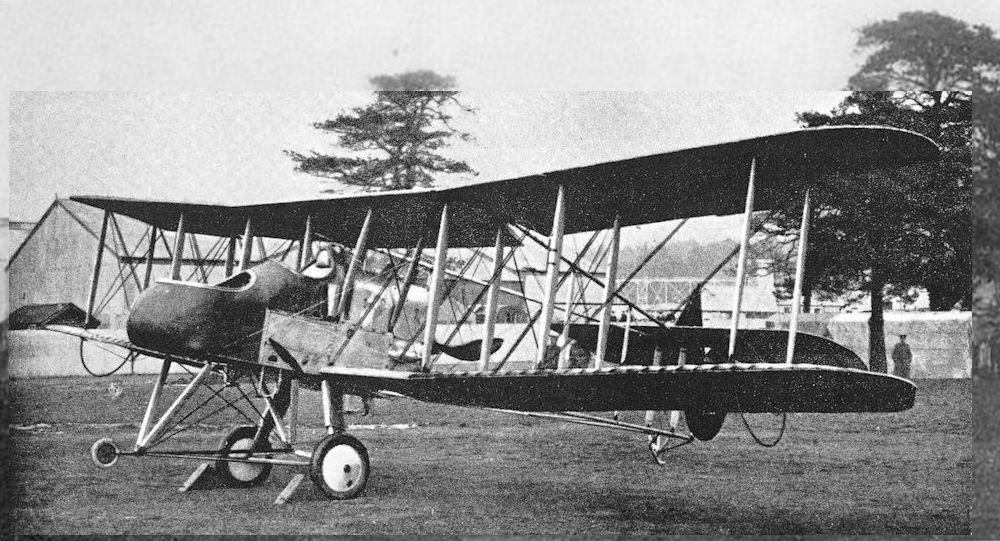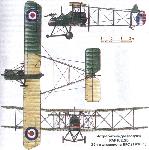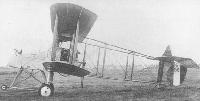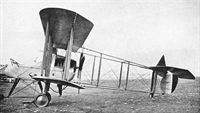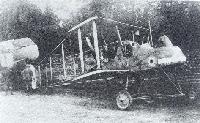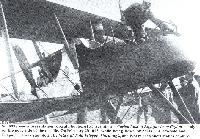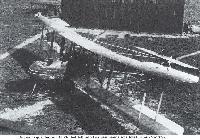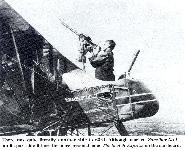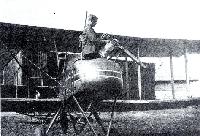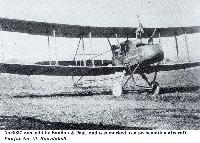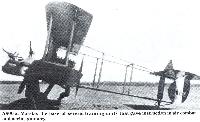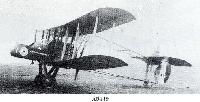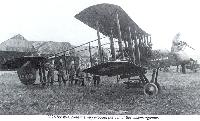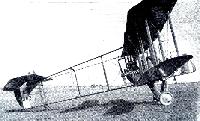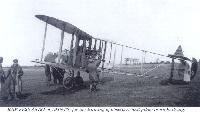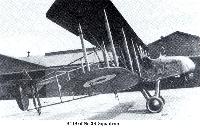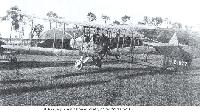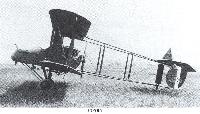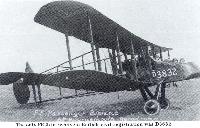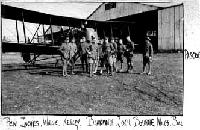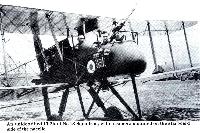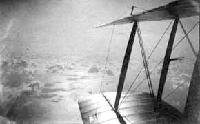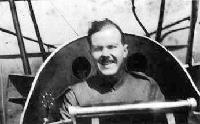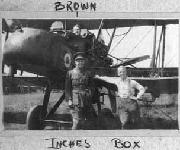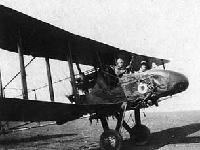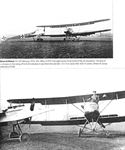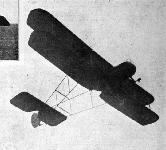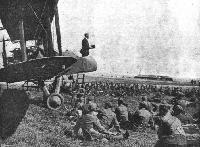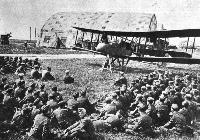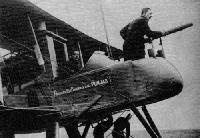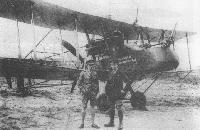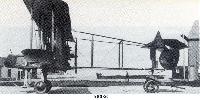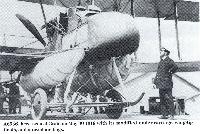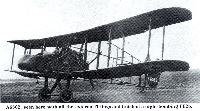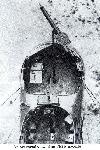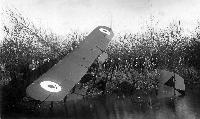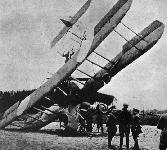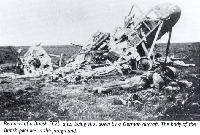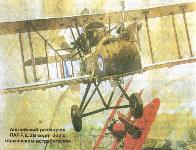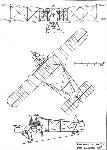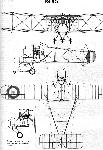В.Кондратьев Самолеты первой мировой войны
РАФ FE.2 / RAF FE.2
Крупногабаритный двухместный цельнодеревянный трехстоечный биплан смешанной конструкции с ферменным фюзеляжем и полотняной обшивкой плоскостей и оперения. Гондола обшита фанерой и шпоном. Продольные балки хвостовой фермы - стальные трубы, поперечные - деревянные. Самолет разработан в КБ авиазавода "Ройял Эйркрафт Фэктори" в августе 1913 года при участии Джеффри Де Хэвилленда.
Почти год аппарат оставался в единственном экземпляре и лишь накануне войны - в июле 1914-го - руководство RFC заказало серию из 12 штук под обозначением FE.2a. Аббревиатура FE обозначала Farman Experimental - "экспериментальный самолет типа "Фарман", так в Англии называли все аэропланы с толкающим винтом.
Первый FE.2a вышел на летные испытания в январе 1915-го. Он был оснащен 100-сильным шестицилиндровым двигателем жидкостного охлаждения "Грин". Мощность мотора оказалась явно недостаточной для столь крупной и тяжелой машины. Поэтому уже в марте появилась модификация FE.2b с двигателем "Бердмор" в 120 л.с. Эта модификация стала наиболее массовой.
Всего построено 1484 FE.2b, большинство из них - на заводе RAF, а остальные - на фирме "Болтон энд Пол" (Boulton and Paul). Серийное производство продолжалось до февраля 1917 года. Часть машин позднего выпуска оснащалась двигателями "Бердмор" мощностью 160 л.с.
Стандартным вооружением FE.2b были два пулемета "Льюис", один из которых подвижно крепился в носовой части гондолы, а второй - на длинной телескопической штанге - между кабинами пилота и стрелка-летнаба. Он предназначался для стрельбы назад поверх бипланной коробки. Правда, это было сопряжено с большой опасностью для стрелка и требовало от него чуть ли не акробатических навыков, поскольку ему приходилось поворачиваться спиной вперед и вставать во весь рост на сиденье, рискуя выпасть из кабины. И все же FE.2 оказался едва ли не единственным самолетом с толкающим винтом, который обладал хоть какой-то защитой от атак сзади. Немецкие истребители обычно опасались в одиночку нападать на эти машины.
На некоторых FE.2b ставили еще и третий пулемет "Льюис" или "Виккерс", жестко закрепленный в курсовом положении на правом борту гондолы. Эти машины предназначались для атак наземных целей.
Первый дивизион, вооруженный FE.2b, прибыл на западный фронт в мае 1915 г. Более года эта машина считалась наиболее хорошо вооруженным аэропланом британских ВВС. Но появление новых немецких истребителей "Альбатрос", "Роланд" и "Хальберштадт" быстро положило конец ее истребительной карьере.
Весной 1917-го FE.2 переклассифицировали в ночной бомбардировщик. В этом качестве самолет поднимал более 150 кг бомб и применялся до конца войны. Некоторые машины использовались в качестве ночных истребителей ПВО, но из-за низкой скороподъемности они не добились каких либо успехов на этом поприще.
К моменту подписания перемирия в ноябре 1918-го на вооружении RAF оставалось еще около 500 FE.2b.
МОДИФИКАЦИИ
F.E.2a - первые 12 экземпляров с двигателем "Грин", рядный шестицилиндровый, жидкостного охлаждения, 100 л.с. Вооружение: 1 подвижный "Льюис" на шкворневой установке для стрельбы в передней полусфере.
F.E.2b - основная серия, с двигателем "Бердмор", 120 или 160 л.с. Разработан в августе 1914 года. Вооружение: 1-2 подвижных 7,69-мм "Льюиса" для стрельбы вперед и назад поверх крыла. Шасси с передним противокапотажным колесом. Наиболее массовая модификация машины. Сделано 1484 штуки.
F.E.2c - "ночная" модификация, кабина пилота размещена спереди для улучшения обзора при посадке. Серийно не строился.
F.E.2d - последняя серия с двигателем Роллс Ройс "Игл", 250 л.с. и новой системой охлаждения. Размах крыльев увеличен до 14,94 м. Начиная с июля 1916-го построено 300 штук на фирме "Болтон энд Пол" и 87 - на заводе RAF. Вооружение аналогично F.E.2b (+ 1 фиксированный курсовой "Виккерс" или "Льюис").
ЛЕТНО-ТЕХНИЧЕСКИЕ ХАРАКТЕРИСТИКИ
(RAF F.E.2b)
Размах, м 14,56
Длина, м 9,84
Высота, м 3,85
Площадь крыла, кв.м 46,00
Сухой вес, кг 962
Взлетный вес, кг 1376
Двигатель "Бердмор"
мощность, л.с. 120
Скорость максимальная, км/ч 129
Скорость подъема на высоту
2000 м, мин.сек 13,00
Дальность полета, км 440
Потолок, м 2740
Экипаж, чел 2
Вооружение 1-2 пулемета
Показать полностью
А.Шепс Самолеты Первой мировой войны. Страны Антанты
RAF F.E.2 1914 г.
Самолет проектировался еще до начала войны как разведчик и легкий бомбардировщик при участии Де Хевилленда. С началом войны самолет версии F.E.2а начал поступать в дивизионы RFC.
Достаточно мощный двигатель позволил при установке пулемета использовать машину для борьбы с самолетами противника. Основная модель самолета - F.E.2b - стала истребителем. Этот самолет состоял на вооружении истребительных дивизионов RFC до конца 1916 - начала 1917 года. Затем оставшиеся машины передали в разведывательные дивизионы.
F.E.2 был ферменный трехстоечный биплан цельнодеревянной конструкции, выполненный по схеме самолетов "Фарман". В носовой части гондолы была кабина стрелка-наблюдателя и пулемет на турели. Далее находилась кабина пилота, перед ней иногда монтировался на шкворневой установке пулемет для стрельбы вверх-назад над крылом. В хвостовой части гондолы закреплялся рядный двигатель жидкостного охлаждения. Радиаторы охлаждения устанавливались перед двигателем по бокам гондолы. Ферма изготавливалась из стальных труб с деревянными стойками и растяжками из стального троса.
Крылья двухлонжеронные, цельнодеревянной конструкции, обтянутые полотном. Оба крыла оборудовались элеронами. Стойки бипланной коробки деревянные, растяжки - стальной трос. Горизонтальное оперение устанавливалось по верхнему поясу ферм и имело конструкцию, аналогичную крылу. Вертикальное оперение без киля, цельнодеревянное, над стабилизатором устанавливался дополнительный форкиль. Шасси двухколесное с резиново-шнуровой амортизацией. Управление рулями и элеронами тросовое. Двигатель (на основной версии) 6-цилиндровый, рядный, жидкостного охлаждения "Бердмор".
Всего построено 1939 самолетов всех модификаций.
Модификации
F.E.2a - первые 12 экземпляров с двигателем "Грин" мощностью 100 л. с. без вооружения.
F.E.2b - основная серия, с двигателем "Бердмор" мощностью от 120 до 150 л. с., вооруженная 1-2 7,69-мм пулеметами "Льюис". Шасси с передним противокапотажным колесом.
F.E.2d - последняя серия с двигателем "Роллс-Ройс" "Игл" мощностью 250 л. с. и новой системой охлаждения.
Показать полностью
В.Шавров История конструкций самолетов в СССР до 1938 г.
Разведчик FE-2b - двухместный разведчик образца 1915 г., трехстоечный биплан толкающей схемы с хвостовой фермой. Двигатель - "Грин" в 73 л. с. Имелось 7 самолетов. Характерный признак самолета - небольшое переднее противокапотажное колесо, соединенное с осью главных колес. Костыль обычный. Ход главных колес был необычно большой. По схеме самолет соответствовал "Вуазенам", которым уступал в летных качествах из-за недостаточно мощного двигателя. Вооружение отсутствовало. Применялся как учебный до 1923 г.
Самолет||FE-2B
Год выпуска||1915
Двигатель , марка||
мощность, л. с.||73
Длина самолета, м||9,9
Размах крыла, м||14,5
Площадь крыла, м2||45,8
Масса пустого, кг||850
Масса топлива+ масла, кг||107+17
Масса полной нагрузки, кг||320
Полетная масса, кг||1170
Удельная нагрузка на крыло, кг/м2||25,6
Удельная нагрузка на мощность, кг/лс||12,6
Весовая отдача,%||27
Скорость максимальная у земли, км/ч||90
Время набора высоты||
1000м, мин||15
2000м, мин||35
Потолок практический, м||3000
Продолжительность полета, ч.||4
Показать полностью
P.Hare Royal Aircraft Factory (Putnam)
F.E.2a
In mid-1914 work was begun on a new version of the pusher format, incorporating lessons learned from the previous F.E. designs and intended, from the start, to carry a Lewis gun. Larger and heavier than the 1913 F.E.2 from which it was derived, the F.E.2a was designed to be powered by the six-cylinder, 100hp water-cooled Green engine which had won the Patrick Alexander Engine Competition, recently hosted by the Royal Aircraft Factory. The outer wing panels were again identical to those of the B.E.2, but this time were taken from the newest variant, the B.E.2c, and therefore incorporated ailerons. These wings were fixed to a centre-section which extended outboard to pairs of interplane struts at the tailboom attachment points, thus giving a three-bay wing structure. The tailplane was mounted on the upper tailbooms and wire-braced from a triangular kingpost which was fabric covered to provide fin area. Further fin area was provided by increasing the chord of the rearmost vertical struts between the tailbooms, and the rudder was aerodynamically balanced. The trailing edge of the wide centre-section was hinged for use as an airbrake, and the undercarriage had oleo legs and a small buffer nosewheel.
In the atmosphere of urgency which followed the outbreak of war a batch of twelve F.E.2as was ordered off the drawing board. The first of these, 2864, made its first flight on 26 January 1915, piloted by Frank Goodden. Unfortunately the Green engine proved to be far too heavy for its power output, and it was therefore decided to substitute the 120hp Austro-Daimler which William Beardmore was by then building under licence in the company's own name. The first F.E.2a thus powered was flown, again by Goodden, on 16 March, and was found to be so much improved that the Beardmore engine was adopted for all the uncompleted F.E.2as. However, delays in engine production resulted in consequent delays in the completion of the aeroplanes, and deliveries dragged on all through the summer of 1915.
The last of the twelve, 5648, was delivered on 5 October. This machine differed from the rest in having a conventional vee-strut undercarriage and wings of R.A.F.14 aerofoil section instead of the R.A.F.6 of earlier machines, reflecting a similar change made to the B.E.2c. The flap-type airbrake was omitted from this machine as it was seldom, if ever, used by service pilots. An experimental braking parachute system which was tested during the spring of 1915 similarly found no favour, particularly as the landing run was not excessive anyway, and was not adopted for general use. This was, however, the first recorded use of such a device.
All twelve F.E.2as saw service with the RFC in France, and were among the few adequately armed aeroplanes that the force possessed. Had the type been available sooner and in greater numbers the struggle for command of the air might have been very different.
Powerplant:
100hp eight-cylinder Green
120hp six-cylinder Austro-Daimler (Beardmore)
Dimensions:
span 47ft 9in
chord 5ft 6in;
gap 6ft 3 1/2in;
wing area 494 sq ft;
incidence (R.A.F.6) 3 1/2°;
length 32ft 3in;
height 12ft 7 1/2in.
Weights:
1,993lb (empty);
2,680lb (loaded)
Performance:
max speed
(100hp) 75mph at sea level;
(120hp) 80mph at sea level;
ceiling 6,000ft;
climb: 8 1/4min to 3,000ft.
F.E.2b
Clearly impressed with the warlike potential of the first F.E.2a, the War Office ordered its mass production by a number of contractors. These mass-produced machines differed from the F.E.2a in a number of ways intended either to improve performance or to simplify production, and were therefore designated F.E.2b to distinguish them from the earlier model. The upper centre-section was revised to eliminate the airbrake, which was not actually used in service, and the fully streamlined underwing gravity tank was replaced by a simpler unit which was easier to produce yet did not cause any significant loss of performance.
The drawings were quickly amended for issue to contractors, enabling the first F.E.2b, 5201 built by Boulton & Paul, to be delivered in October 1915, concurrently with the last of the F.E.2as.
Early examples were powered by the 120hp Beardmore engine and had wings of R.A.F.6 aerofoil section rigged at an incidence of 3 1/2°. Wings of R.A.F. 14 section were substituted early in 1916, following their introduction for the B.E.2c, and resulted in generally improved performance, although the rate of climb at altitudes above 5,000ft suffered slightly owing to the increased angle of incidence required by the new wings.
A need for increased endurance, combined with the adoption of the uprated and therefore thirstier Beardmore engine (which had an increased cylinder bore and gave 160hp), led, in March 1916, to the provision of an additional eighteen-gallon tank under the pilot's seat.
A variety of mountings were tried for the observer's Lewis gun, each giving an excellent field of fire forwards and to the sides, but defence against attack from behind depended upon the observer/gunner being sufficiently brave to stand up in the full force of the slipstream and fire backwards over the upper wing. Flights of the big pushers, known officially as 'Battleplanes' and affectionately as 'Fees', roamed the skies over the lines on 'offensive patrol', thus offering some protection to the unarmed reconnaissance machines and taking the war to the enemy in accordance with the beliefs of Brig-Gen Trenchard, Commander of the RFC in France. Their presence did much to combat the 'Fokker scourge' for, although they lacked sufficient speed to chase and catch the enemy fighters, they were formidable opponents once battle had been joined.
An effort was made to improve the F.E.2b's performance by replacing the efficient but fairly massive oleo undercarriage by a simple vee-strut structure similar to that common to other aeroplanes, such an installation having previously been made to the last of the F.E.2as. Although this modification obviously reduced drag and thereby effected a small but useful increase in speed and climb, the improvement was achieved at the expense of the machine's previous ease of landing, and the change was not universally popular within the RFC, being particularly unwelcome among the less experienced pilots. However, Lt Trafford Jones of 20 Squadron later devised a modification to the oleo undercarriage which greatly reduced its drag by eliminating the 'buffer' nosewheel, together with the struts needed to support it, while retaining its strength and efficiency. This simple modification was therefore adopted for all future F.E.2bs, and at the same time the lower longerons were changed from spruce to ash, presumably to increase their strength, because the landing shocks were less dispersed than with the original undercarriage.
By the middle of 1916 the role of the F.E.2b began to change as it became outdated as a fighter. The generous lift of its broad wings prompted its adoption as a bomber, a duty in which it continued throughout the war, switching to nocturnal operations as it became too far outclassed for daytime use. In this role its vee-strut undercarriage was found to be a definite advantage, as it allowed sufficient clearance for a 230lb bomb to be carried beneath the nacelle, which the oleo version did not.
Constant problems with the Beardmore engine, which often needed a complete overhaul after only a few hours' flying, led to the experimental installation of the only available alternative, the 150hp R.A.F.5, F.E.2b - 6360 being so equipped in March 1916. However, the reduction in power cannot have enhanced the machine's already outdated performance, and no service machines were thus powered.
Experiments with the F.E.2b's armament continued throughout the war. A number had their nacelles modified to accommodate a quick-firing Vickers one-pounder together with a belt of forty shells, and a handful of such machines saw active service, being used in particular for attacks upon road and rail transport.
In October 1916 one example, 4928, was fitted with a small searchlight mounted on the undercarriage near to the nosewheel, the power being supplied by a propeller-driven generator mounted on the nose of the nacelle. An installation of a larger light was made on A781 in March 1917. This light had two Lewis guns attached to it, and was mounted on the machine's nose, where it could be aimed by the observer. In this case the necessary generator was suspended below the front of the nacelle. Although they were designed with the intention of equipping the F.E.2b as a night fighter, these installations can only have been regarded as experimental, and neither was adopted for wider use.
Another experimental installation which was not adopted for service use was a device intended to deflect the cables of barrage balloons. This comprised a 'bowsprit' projecting from the nacelle, from which a stout cable extended to each wingtip. The aircraft thus equipped was deliberately flown into suspended wires by Roderic Hill, but a number of mishaps caused the tests to be discontinued before a fatality occurred.
A proposal, made in April 1918, that the F.E.2b should be used for anti-submarine patrols (the role for which the C.E.1 had previously been designed), led to the development of emergency flotation bags, fastened below the nacelle, for use if an engine failure forced such a machine to ditch into the sea. Trials, which included at least two ditchings, were successfully conducted at the Isle of Grain but, perhaps fortunately, there is no record of any pilot having to deploy the bags 'in anger'.
Use of the F.E.2b ceased almost immediately upon the signing of the Armistice, although one was retained at the RAE as a test vehicle until some time in 1924.
Only one example, D3822, found its way on to the civil register, spending a few years as G-EAHC with the Bournemouth Aviation Company, giving joy rides.
Powerplant: 120hp six-cylinder (Beardmore) (later 160hp)
Dimensions: As F.E.2a.
Weights:
120hp 1,993lb (empty); 2,967lb (loaded).
160hp 2,061lb (empty); 3,037lb (loaded).
Performance:
120 hp
max speed 80mph at sea level;
ceiling 9,000ft;
climb: 9min 50 sec to 3,000ft.
160hp
max speed 88mph at sea level;
92mph with vee undercarriage;
ceiling: 11,000ft;
climb 7min 24 sec to 3,000ft;
endurance 3hrs.
F.E.2c
The first machine to bear the designation F.E.2c was built as an F.E.2a (possibly either 5644 or 5646), and had the crew positions reversed to place the pilot in front but was otherwise of normal configuration. This modification was apparently made to improve the pilot's view, particularly for night landings, but the change so restricted the observer's field of fire that the idea met with little favour from its intended users, a situation which the provision of a forward-firing Lewis gun for the pilot did little to improve.
At the same time, October 1915, the Factory was adapting a number of production F.E.2bs to the new configuration and, in view of the pilot's disapproval, work was stopped when only two, 6370 and 6371, had been converted. The former machine was retained at Farnborough for continued trials, but 6371 was sent to France in April 1917, possibly in the erroneous belief that it was a standard F.E.2b, and served briefly with 22 Squadron before being written off in a crash in July.
The final appearance of the type was made late in 1917, when six F.E.2bs were converted to the 'c' configuration, with the pilot's cockpits in front, and served with 100 Squadron. They were probably equipped with Vickers quick-firing guns.
Dimensions: As F.E.2b.
F.E.2d
In what now seems to have been an almost desperate attempt to improve the performance of the sturdy but somewhat sluggish F.E.2b, a new variant, designated F.E.2d, was designed early in 1916, powered by the 250hp Rolls-Royce Eagle V-12 engine. The airframe remained unaltered except for those detail changes necessary to accommodate the new engine, but the fuel system was modified to allow the storage of an additional twelve gallons of petrol.
The prototype, 7995, was completed, ready for inspection, by 4 April 1916, and flew for the first time three days later with Frank Goodden at the controls. Although the massive increase in power brought about only a small increase in top speed, and manoeuvrability and landing speed were adversely affected, the rate of climb and service ceiling were sufficiently improved to justify its adoption, especially as the Beardmore engine normally used in the F.E.2b was far from reliable. Production was therefore undertaken at the Royal Aircraft Factory and by Boulton & Paul of Norwich.
The Factory seems to have worked with commendable dispatch, and A 1, the first of a batch of forty machines, was completed by the end of May. The last machine was delivered by the end of August.
To facilitate the removal of the massive engine from its mounting, surrounded by tailbooms and bracing wires, the Factory designed a portable hoist with which the engine could be lifted clear and lowered to the ground or on to a bench.
The radiator designed for use with the Rolls-Royce engine was found, in practice, to be too large, resulting in excessive cooling. Although shutters, operated by the pilot, went some way towards alleviating the problem, they relied principally on his intuition for correct operation, and provided a distraction which was wholly unwelcome in a combat aircraft. The final solution turned out to be remarkably simple; the radiator previously used for the Beardmore engine was substituted, but installed without the cowlings fitted to the earlier variants so that it received the full effect of the airflow. Shutters were still fitted to allow a faster warm-up, especially during colder weather.
The modification to the oleo undercarriage which eliminated the nosewheel, and which was already in use on the lower-powered F.E.2b, was tested on the '2d' towards the end of August 1916, and was adopted for all new machines with effect from 15 October.
Unfortunately the German air force became familiar with the new machine almost as quickly as did the RFC, for A5, one of the first F.E.2ds to go to France, was ferried across the Channel by an inexperienced crew and inadvertently landed, without serious damage, on the wrong side of the lines, near Lille, effectively making a present of it to the enemy.
The F.E.2d had originally been conceived as a stopgap until the problems with the 160hp Beardmore engine could be resolved, and some machines, ordered as Rolls-Royce-powered '2ds' were actually completed with the smaller engine. The type continued in service, alongside its forebear, the far more numerous F.E.2b, and many other, newer designs until the end of the war.
In April 1917 work was started on the design of a seaplane version of the F.E.2d, but before much work had been done the scheme was dropped in favour of the C.E.1 project.
Powerplant: 250hp Rolls-Royce Eagle V-12
Dimensions:
span 47ft 9in;
chord 5ft 6in;
gap 6ft 3 1/2in;
wing area 494 sq ft;
length 32ft 3in;
height 12ft 7 1/2in.
Weights: 2,509lb (empty); 3,469lb (loaded).
Performance:
max speed 97mph at sea level;
ceiling 17,000ft;
climb 6min to 3,000ft; 14 1/2min to 6,000ft;
endurance 3 1/2hrs.
F.E.2e,f,g&h
Although relatively few details survive of the variants to which these designations were applied, it is recorded that the F.E.2h was a standard F.E.2b or d modified to accept the 230hp Siddley Puma in an effort to conserve stocks of the Rolls-Royce Eagle, which was in great demand for other designs, while producing an aeroplane of equivalent performance.
The prototype was produced late in 1917 by the conversion of an existing F.E.2d, A6545, the actual work being undertaken by Ransomes, Sims & Jefferies. Testing at Martlesham Heath, with both vee and oleo undercarriages, was undertaken early in 1918, and proved that the new variant's performance was little better than that of the F.E.2b and much lower than that of the Eagle powered F.E.2d. Nevertheless, three more Boulton & Paul-built machines, A6501-6503, were converted to the Puma engine, the work again being undertaken by Ransomes, Sims & Jefferies. These were renumbered E3151-3153, and were tested at the Isle of Grain armed with the recoilless six-pounder Davis gun.
Various other engine installations were tested, including the R.A.F.5, and all failed to find approval. It is believed that the remaining designations were to have been applied to these machines if they were placed into production, thereby forestalling the confusion which had arisen with the early B.E.2es.
Powerplant: 230hp six-cylinder Siddeley Puma
Dimensions: As F.E.2d.
Weights: 2,280lb (empty); 3,355lb (loaded).
Performance:
max speed 93mph at sea level;
ceiling 14,000ft;
climb 11 1/2min to 6,000ft;
Показать полностью
O.Thetford Aircraft of the Royal Air Force since 1918 (Putnam)
FE 2b and FE 2d (Royal Aircraft Factory)
First introduced as a two-seat fighter on the Western Front in January 1916, the FE 2b and its successor the FE 2d were later employed extensively in the night bombing role, and on 1 April 1918 remained in service performing this duty with Nos 38, 83, 100, 101, 102, 148 and 149 Squadrons, as well as on Nos 191, 192, 199 and 200 Squadrons for night training. The last aircraft remained with No 149 Squadron at Bickendorf in Germany until March 1919. Powerplant: One 120hp or 160hp Beardmore engine. Span, 47ft 9in; length, 32ft 3in; loaded weight, 3,037lb; max speed, 81mph at 6,500ft; initial climb, 210ft/min; ceiling, 11,000ft.
Показать полностью
F.Manson British Bomber Since 1914 (Putnam)
Royal Aircraft Factory F.E.2B Bomber
The venerable F.E.2 (Farman Experimental) was originally flown long before the War, and production examples of the first variant, the F.E.2A, were sent to France in January 1915 - the first British aeroplanes designed for air combat to reach the RFC. As such the F.E.2A was to shoulder much of the early responsibility for defence against the Fokker monoplane scouts over the Western Front, a brave but largely ineffective defence owing to the aircraft's deficiencies in performance and agility.
When British purpose-designed dogfighters, beginning with the Airco D.H.2, began arriving in France, some of the pressure was removed from the F.E.2As and 2Bs - the latter with 120hp Beardmore engines - and the opportunity was taken to investigate the possibility of operating the F.E.2B at night, and No 6 Squadron flew a number of night patrols from Abeele, confirming that the aircraft was indeed suitable for night operations, provided that the outrigged nosewheel was removed; to begin with, however, the oleo struts were retained, until these were replaced by plain V-struts. Late production F.E.2Bs were powered by the 160hp Beardmore, but this engine initially proved unpopular owing to unreliability.
By the spring of 1916 a new generation of German fighting scouts had started appearing over the Front, and new efforts were made to find a substantially more powerful engine for the F.E.2, and the choice fell upon the new 250hp Rolls-Royce, soon to be named the Eagle. The version thus powered, the F.E.2D, entered production in March and the first example to be dispatched left for France on 30 June, only to be captured intact by the Germans later that day when its pilot landed at Lille in mistake for St Omer.
This aircraft had been intended for No 20 Squadron at Clairmarais, and subsequent deliveries were safely made during the following month, the Squadron being engaged in converting from the F.E.2B during the Battle of the Somme. No 57 Squadron, also flying the F.E.2D, arrived in France during December that year, and No 25 Squadron converted in March 1917.
By then, however, it was recognized that the slower F.E.2B was fatally vulnerable in daylight operations, and it was No 6 Squadron, drawing on its previous night flying experience, which flew the first significant night bombing sorties on the night of 16/17 November 1916, when four aircraft, each carrying three 100 lb bombs, took off to attack targets of opportunity - and achieved notable success against enemy rail targets.
With a relatively large number of F.E.2B squadrons now in service (and a shortage of Rolls-Royce engines threatening early in 1917), the decision was taken to retain the 2B in service as a night bomber, a role it continued to perform for the remainder of the War. On the other hand, the F.E.2D (of which very few were ever flown with bombs) was withdrawn from front-line service before the end of 1917.
Results of the early night attacks by No 6 Squadron were examined closely by the War Office, and the first dedicated night bombing Squadron to be equipped with F.E.2Bs was No 100, which was formed at Hingham in Norfolk on 23 Februarv 1917 and moved to France the following month, where it was placed under the direct command of RFC HQ. The aircraft flown by this Squadron featured the plain V-strut undercarriage, without oleos, as standard, for this configuration permitted the aircraft to carry a 230 lb RL bomb, whereas the gear with oleos did not.
During the first week of July No 100 Squadron twice raided targets at Douai, location of a German fighter aerodrome and, during an attack on the night of the 7th/8th included a pair o f newly-arrived F E.2Bs each armed with a single Vickers one-pounder quick-firing gun. Although these guns, which continued to be used for about three months, were found to be quite effective so long as they continued firing, any stoppage that occurred could not be rectified in the air; there was also a danger that spent shell cases could foul the propeller. Aircraft armed with the one-pounder (also flown by No 102 Squadron) were distinguishable by the side-by-side disposition of the crew, the gunner being seated to the right of the pilot.
In August No 100 Squadron was heavily engaged during the battles of Messines and Ypres, dropping four-and-a-half tons of bombs in attacks on Mouveaux aerodrome and on railway targets at Comincs, Courtrai, Menin and Roulers on the night of the 16th/17th. This series of raids presaged a continuing bomber offensive that lasted through the autumn and winter, and was joined by the bomb-carrying F.E.2Bs of Nos 58,83,101,102,148 and 149 Squadrons although, with Trenchard's creation of the 41st Wing for the strategic bombing of German industrial targets, No 100 Squadron, itself coming to be regarded as the spearhead of the RFC's night bombing effort, was transferred to the new force on 11 October 1917. Its first major attack with the Wing was flown on the 24th of that month, when fourteen F.E.2Bs accompanied nine naval Handley Page O/100s to bomb the Burbach factory near Saarbruchen.
As early as January 1917 it had been assumed that, with the F.E.2B's approaching obsolescence, its value as a bomber would be short-lived, and for several months its production was allowed to run down, and would have ceased altogether by the end of that year had not No 100 Squadron's early successes suggested that the F.E.2B represented an economical, and by all accounts effective bombing weapon by night. Therefore, as new squadrons were about to be formed and others transferred to the night bombing role, new orders were placed for F.E.2B production - so much so that as late as the third quarter of 1918 its production rate was still accelerating. Indeed, at the date of the Armistice, the venerable pusher bomber was still serving with six front-line squadrons, while a further six were training on the type in the United Kingdom.
That the F.E.2B was outdated long before the end of the War is undeniable, and it was quite fortuitous that the art of night fighting was still in its infancy, so that bombing by night could be, and was performed with some impunity by both sides. Yet the old pusher aeroplane demonstrated a number of important attributes that recommended it for such operations: it possessed docile handling qualities and was straightforward to land at night, and with the engine located aft the crew was afforded an excellent field of view, unimpeded by exhaust flash. With generous wing area and ample power, it could lift a 230 lb bomb or, perhaps surprisingly, as many as fourteen 25 lb bombs (The actual weight of the Cooper '20-pounder' with fragmentation case) - the latter a most appropriate armoury for use against diffuse targets such as trains and other troop transport.
Type: Single pusher engine, two-seat, three-bay biplane as employed as a night bomber.
Manufacturers: The Royal Aircraft Factory, Farnborough, Hampshire; Boulton & Paul Ltd, Norwich, Norfolk; Richard Garrett & Sons, Leiston, Suffolk; Ransome, Sims & Jefferies, Ipswich, Suffolk; G & J Weir, Cathcart, Glasgow.
Powerplant: F.E.2B as bomber. 120hp or 160hp Beardmore six-cylinder, water-cooled, inline engine driving four-blade pusher propeller. F.E.2D. One 225hp Rolls-Royce (Eagle I).
Dimensions: Span, 47ft 9in; length, 32ft 3in; height, 12ft 7 1/2 in; wing area, 494 sq ft.
Weights (160hp Beardmore): Tare, 2,061 lb; all-up, 3,037 lb.
Performance (160hp Beardmore): Max speed, 91.5 mph at sea level, 76 mph at 10,000ft; climb to 10,000ft, 39 min 44 sec; service ceiling, 11,000ft.
Armament (as a bomber): Usually a single 0.303in Lewis machine gun, bracket-mounted on the front cockpit. 160hp Beardmore-powered night bombers could carry up to three 112 lb bombs when flown as single-seaters, or one 230 lb bomb when flown as two-seaters; combinations of smaller bombs were sometimes carried, equivalent to these bomb loads.
Production: Total number of F.E.2Bs converted or built and flown as bombers is not known (some sources give the total as about 860). The following figures refer to the entire new production of F.E.2Bs and F.E.2Ds (1,810 aircraft). Royal Aircraft Factory, 137 (Nos 6328-6377 [Bs], No 7995 [D], A1-A40 [Ds], A1932-A1966 [Ds], A5143-A5152 [Ds] and A8950 [B]); Boulton & Paul, 550 (Nos 5201-5250 [Bs], 6928-7027 (Bs), 7666-7715 [Bs], A6351-A6600 [Ds], B1851-B1900 |Ds] and A5438-A5487 [Bs]); Garrett, 60 (D3776-D3835 (Bs]); Ransome, Sims & Jefferies, 250 (B401-B500, C9786-C9835 and D9900-D9999, all Bs); Weir, 650 (Nos 4838-4937, A778-A877, A5500-A5649, A5650-A5799 and D9081-D9230, all Bs); constructors not known (probably R.A.F., Farnborough), 163 (Nos 4938-5000 and E7037-E7163, all Bs). Bomber conversions are known to have been made in almost all the above batches.
Summary of Service: F.E.2Bs operated regularly as night bombers with Nos 58, 83, 100, 101, 102, 148 and 149 Squadrons, RFC and RAF, and with No 3 Naval Wing, RNAS, in France. They were also flown by numerous other squadrons over the Western Front on short-range bombing-reconnaissance attacks.
Показать полностью
M.Goodall, A.Tagg British Aircraft before the Great War (Schiffer)
Deleted by request of (c)Schiffer Publishing
FE.2a biplane
The FE.2a was a new type of two-seater pusher biplane, the design of which began in the middle of 1914, the first aircraft flying on 26 January 1915, piloted by Frank Goodden.
The aircraft was considerably bigger and heavier than the earlier FE.2 types, with a very deep nacelle, reduced at the front to seat the observer in an exposed position, with a wide area of view. The machine was fitted with BE.2c wings, but without stagger, for the two bays outboard of the wide center section. The center section trailing edge was hinged to form a flap intended to be used as an airbrake, but this was discarded on later production aircraft. The undercarriage had oleo legs and a nose wheel which required a complex arrangement of supporting struts.
The tailplane was mounted on the top of the tail booms, with a triangular fin above, as a kingpost for bracing wires. The rearmost struts in the tail booms were wider in chord to provide additional fin area ahead of the large aerodynamically balanced rudder.
Small side air intakes provided cooling air to the radiator for the cowled Green engine, which was originally fitted, but which was soon replaced by a Beardmore engine of lighter weight.
Twelve machines were ordered straight off the drawing board and, although delay occurred in delivery due to slowness of engine deliveries, the aircraft were dispatched by October 1915, and all saw service in France. The FE.2a. was later developed through the FE.2b to FE.2h, and was a successful aircraft in the early part of the war and was used in various roles until the Armistice.
Power:
100hp Green six-cylinder inline water-cooled driving a two-bladed propeller
120hp Beardmore (Austro-Daimler) six-cylinder inline water-cooled
Data
Span
47ft 10in plain ailerons
50ft 1in balanced ailerons
Chord 5 ft 6in
Gap 6ft 3 l/2in
Area 494 sq. ft
Length 32ft 3 l/2in
Weight 1,993 1b.
Weight allup 2,680 lb.
Max speed
75 mph at sea level (Green)
80 mph at sea level (Beardmore)
Climb to 3,000ft 8 l/4min
Показать полностью
H.King Armament of British Aircraft (Putnam)
F.E.2a. A single Lewis gun was the armament of this fighter/reconnaissance two-seater, first constructed in 1915. The gun was mounted on a tubular arm, pivoted to the floor of the front cockpit. The underside of the nacelle was armoured and an angular tubular framework built over the nose may have afforded protection for the aircraft structure against misdirected fire from the gun.
F.E.2b. To the single pillar-mounted Lewis gun of the F.E.2a, which had an arc of fire of about 180 degrees, there was added, as a more or less standard fitment on the F.E.2b, a second Lewis gun on a telescopic pillar mounting between the cockpits. In order to man this gun, the gunner stood on the cupboard which contained spare parts and miscellanea and fired rearwards above the pilot's head. The pilot could fly with one hand and operate the rear gun with the other. Sometimes two pillar-mounted guns were installed between the cockpits. When the pillar or pillars were fully extended, the gunner's insteps were on the upper rim of the plywood-covered nacelle. An F.E. gunner was almost as much acrobat as marksman. Arch Whitehouse recalls of one energetic occasion:
'By the time we were back opposite Arras, the empty gun drums were rattling around the bottom of my nacelle and the canvas bag bolted to the side of my gun to catch the empty cartridges was jammed to its capacity.'
In the spring of 1916 an experimental insiallation was made of a Vickers 1-pounder 'Pom-pom', of the type which had been used in the Boer War, and two aircraft having this armament were delivered about a year later to No. 100 Squadron for ground-attack work. No. 102 Squadron used the same armament. Among difficulties encountered were malfunctioning of the gun, the fierce recoil - which on one occasion at least snapped the engine holding-down bolts - and the shell cases which were blown back into the airscrew. The Pom-pom gunner sat to the pilot's right and could elevate or depress the gun in a slot formed in the nacelle. A special form of sight appears to have been fitted on a fore-and-aft tube on top of the nacelle. A few F.E.2bs used for Home Defence had a Pom-pom gun; two had a 0.45-in Maxim gun, and some had a Lewis gun on a n Anderson mounting. This type of mounting comprised a tubular inverted-U member braced to the nacelle and having a central pivoted pillar to which the gun was attached. At Farnborough early in 1917 an installation was made of two Lewis guns, one fixed to each side of a Harle searchlight for simultaneous training. There was also an installation of twin-yoked Lewis guns without the light. Some Home Defence F.E.2bs were single-seaters, either with the front cockpit faired over or with a special top decking. One or two fixed Lewis guns sometimes formed the armament and there were instances of a Lewis gun on a normal telescopic mounting. In training units a Scarff ring-mounting was tilted.
Good load-carrying ability, tractability and field of view made the F.E.2b an attractive proposition as a bomber. A single 230-lb bomb could be carried, but two of 112 lb was a commoner load. Three 112-lb bombs could be lifted. Other types of bomb carried were of 100 lb (anti-submarine F.E.2bs carried two), 40-lb Phosphorus and 20 lb, the last-named up to fourteen in number. One identified load was one 112-lb + eight 20-lb. Bomb rails were fitted under the lower inner wings and fuselage, and a C.F.S. bombsight was mounted at the starboard side of the pilot's cockpit. The F.E.2bs of No. 149 Squadron were adaptable for bombing or reconnaissance, having special carriers designed by one of the squadron mechanics to take bombs or Michelin flares without modification.
F.E.2c. In this relatively little known F.E. variant the crew positions were transposed and the shape of the nacelle was much modified. The pilot sat considerably aft of the nose, and a Lewis gun was mounted low in the nacelle ahead of him. This gun could be trained by the pilot over a limited arc in conjunction with a sighting bar forward of the windscreen. A second Lewis gun, worked by the observer, was fitted on an Anderson mounting behind the pilot's seat. Some parts of the nacelle were armoured.
One F.E.2c was fitted with an experimental gun mounting of unknown type and another was used for gyroscope tests, though whether these were in connection with bombsight development is not known.
The designation F.E.2c was also applied to a version of the F.E.2b bomber with transposed crew stations.
F.E.2d. The F.E.2d and its armament are epitomised in the following excerpts from two memorable articles by W, C. Cambray. M C , (No.20 Squadron) which appeared in Flight International during December 1968 under the title 'We Stood lo Fight':
'On joining the unit I became friendly with a Canadian observer, and we found ourselves greatly impressed by the F.E.2d biplane and its armament - 250 h.p. Rolls-Royce engine, 47 ft wing span, three Lewis guns, a camera, eight Cooper 20-lb bombs and 1.000 rounds of ammunition (one in every three of them tracer). We realised immediately that to stay alive we must become 100 per cent familiar with the machine. We spent much time in jumping from the front gun to the rear gun, standing up in the cockpit to fire over the back and then jumping down again. We practised, also, lying on the range with loaded Lewis guns by our sides, and at a shout of "Now!" seeing who could fire at the target first. This, I think, was one good reason why we both managed to survive the experiences that were to follow.
'As No.20 was mainly a fighter squadron an observer quite often went west during his first encounter. If he was lucky enough to return he was good for one more; and if he returned after three fights he was so experienced that, with luck, he would last six months and return to England for Home Establishment. But the proportion who thus returned was indeed small.
'The usual perch for the observer was on the side of the cockpit, always on the watch above and to the rear. As leader of a patrol my pilot would instruct other pilots in the formation of three, five or eight to keep close "but not too damned close, for fear of collision". I well remember a dog-fight in which another machine passed over us so close that I could have reached up and touched it; a nasty thought, for we had no parachutes.
'The enemy usually collected a formation of six, then perhaps an additional eight, and when there were about 20 of theirs to five of ours they would come close in to attack. 1 would thereupon fire a red Very light, which told our formation we were going to fight.
'We would then go round and round in a big circle, each pilot following the tail of the man in front, and always making the whole circle approach gradually closer to our own lines Should a Hun dive to attack, the observer of one machine in the circle would fire his top gun and the observer of the next machine would use his front gun, so that at any given time the attacker would have two guns firing at him.
'A close understanding between pilot and observer was essential. On one occasion I was with a new but good - pilot who had not previously been in a fight. We were flying in a formation of only three aircraft when we became engaged in a brief but rather exciting encounter. A Hun dived from our rear and I could see his tracer bullets going under us as I stood up firing over the tail. I signalled to the pilot to throw the machine about to get rid of him; but, to my surprise, he did only a simple aerodrome-style turn. The Hun climbed again and made another attack, and this time I was fortunate enough to hit him and see him going down out of control while we did a second aerodrome turn. On returning to the squadron I asked my pilot in no uncertain terms why he had not thrown the machine all over the place. "I was afraid I'd chuck you out," he answered. I replied that it was my job to slay in. A very minor incident, perhaps, but one illustrating the necessity of close cooperation.
'Our ceiling was 17.500 ft and we did our best to get there, because the anti-aircraft fire was pretty accurate; but a little drift to the left, a little to the right and an occasional about-turn kept us reasonably safe. On the odd occasion the machine would give an appreciable lift as air was displaced by a passing shell that eventually burst well above us. At this height, with no oxygen, of course, the moving from one gun to the other was quite an exertion and made one pant a good deal.
'A useful manoeuvre in dog-fights was the Immelmann turn, but it could be disconcerting when the machine hung momentarily on one wing-tip and everything, including the observer, started to fall out of it. However, the F.E.2d usually scooped everything up in the nick of time and all was in order again. Which reminds me that another pilot and I decided to try to loop one of these machines. We had arranged for it to be rigged tail-light to help it to get over, and we intended to strap ourselves well and truly in. However, the pilot was killed before we could try; and nobody else was game - which, on mature consideration, was probably just as well.
'Bombing was something of an experience, as it was necessary to fly over the target once to set the bomb sight and a second time to release the bombs. We loaded our 20-lb Cooper bombs four under each wing. They were released by pulling a Bowden cable in the pilot's cockpit; as they fell away their wind vanes would rotate, making them live before reaching the ground.
'There was the odd occasion when the bomb fell forward but was caught by its tail in the rack. The vane began to rotate, and soon the bomb was live. The observer would signal the pilot to throw the machine about, and it was then a relief to see the bomb fall clear.
'At one time we were told we would have Bristol Fighters to replace the F.E.2ds. We were not at all pleased, as the pusher's rear-mounted engine gave the Hun something to fire into and was a protection for the pilot and observer. The Bristol, being a tractor machine, made the observer feel he was rather easy meal.'
It remains to add to the foregoing stirring account that of the three Lewis guns mentioned one was fixed for the pilot's use, as shown in a photograph. Sometimes two fixed guns were fitted, and there was also an installation of twin pillar mountings in the nose of the nacelle, also illustrated. The '1.000 rounds' of ammunition mentioned would comprise ten 97-round drums.
Показать полностью
P.Lewis The British Fighter since 1912 (Putnam)
But new equipment was on the way. Some sixteen months earlier, in August, 1913, the Royal Aircraft Factory had drawn up a two-seat pusher biplane as an original fighter design from the outset. Designated F.E.2a it remained an unbuilt project until the war started. The War Office then decided that the R.F.C. needed a potent fighter immediately and ordered twelve from the Factory. Some five months elapsed before the prototype F.E.2a was ready in January, 1915, and when it appeared it could be seen that the new machine had lost the fairly shapely lines which had graced the last version of the F.E.2. The F.E.2a, with its three-bay 47 ft. 9 in. span wings, enlarged nacelle and sturdy oleo undercarriage, was a pugnacious, hefty-looking machine powered with a 100 h.p. Green engine driving a two-blade propeller. The Green was shrouded by a metal cowling and the pilot was raised well up in his cockpit so that he could see comfortably over the observer in front of him. Between the tail booms the trailing edge of the upper wings was hinged so that, aft of the rear spar, it could be turned down to function as a landing flap. The pair of skids on the undercarriage converged at the front to carry a small third wheel as a nose-over preventative. Although the Green power plant had been exceedingly useful a few years previously in getting many different early machines into the air, its comparatively low power/weight ratio told against it in a type which, for its role, demanded the best possible performance.
Within two months, in March, 1915, a revised version using the more powerful 120 h.p. Beardmore appeared and was redesignated F.E.2b. The new engine was mounted without a cowling and another alteration was the deletion in the F.E.2b of its predecessor’s airbrake. Although the need was so great, production was extremely slow in getting under way and it was not until another eight months had passed that the initial order for twelve was completed. The first arrived in France on 20th May, 1915, for use by No. 6 Squadron but it took a further four months to enable the unit to muster but four F.E.2bs. As a design, therefore, the F.E.2b was more or less obsolescent by the time that it started flying over the lines but, none the less, proved itself a very useful type.
<...>
Even though the pusher layout had patently had its day by mid-1916, the F.E.2b continued to soldier on and was revised in two examples, designated F.E.2c, which were built as night-fighters; the main alteration was that the pilot’s cockpit was the front one.
Following the pair of F.E.2cs came the F.E.2d, which set out to achieve better performance by using the excellent new 250 h.p. engine from Rolls-Royce, the first of a magnificent line of peerless aero-engines from the same firm.
Later to receive the name of Eagle, the 250 h.p. Rolls-Royce had been designed during 1914 by Henry Royce and his chief assistant A. G. Elliott. The intended rating was 200 h.p., but on test in October, 1915, under six months from the time drawings were commenced, the twelve-cylinder water-cooled engine gave 225 b.h.p. Further development produced 266 b.h.p. by March, 1916, 284 b.h.p. by the following July and 322 b.h.p. by the end of the same year.
In the F.E.2d the Eagle gave the two-seat pusher fighter an extended lease of life and the new machine arrived in France in time for the operations during the Battle of the Somme which started at the beginning of July, 1916. Unfortunately, owing to the landing of the first F.E.2d to be sent to France on 30th June in German-held territory, the potentiality of this latest arrival at the Front was revealed to the enemy before it went into action. Notwithstanding, in spite of its obsolescence as a concept and its bulk and clumsy appearance, the F.E.2d gave valiant and untiring service. The type was used to undertake varied experiments in armament and attempted also to intercept Zeppelins but its efforts to aid Home Defence were not conspicuously successful.
Показать полностью
F.Mason The British Fighter since 1912 (Putnam)
Royal Aircraft Factory F.E.2
Origins of the Royal Aircraft Factory’s F.E.2 lay in Geoffrey de Havilland’s second aeroplane, which was bought by the Factory on his appointment as designer and pilot at Farnborough at the end of 1910. It was initially named the F.E.1 (Farman Experimental, on account of its resemblance to contemporary Farman biplanes), but after a crash it was re-built in September 1911 with a 50hp Gnome engine and re-designated the F.E.2. It was again re-built, this time with a 70hp Renault, in 1913, but crashed the following year. In the meantime de Havilland had prepared a new design, ostensibly based on the F.E.2 yet bearing little resemblance to the previous aeroplane, being a three-bay pusher biplane in which an observer-gunner occupied the front cockpit, with the pilot’s cockpit behind and raised about eighteen inches. This version, the F.E.2A, appeared early in 1915 and was designed as a fighting aircraft from the outset, so the designation was accordingly changed to Fighting Experimental. A dozen aircraft were ordered for the RFC to be powered by the 100hp Green, but this was found to be unsatisfactory owing to poor power-weight ratio and the next version, the F.E.2B, was modified to take the 120hp Beardmore driving a two-blade propeller, the top half of the engine being uncowled.
The F.E.2B was ordered into production at the Factory and four sub-contractors, and the first aircraft was handed over to the RFC in May, being delivered to No 6 Squadron at Abeele in France, commanded by Maj G S Shepherd. The first aircraft was flown to France by Capt Louis Arbon Strange (later Lt-Col, dso, obe, mg, afc*) on 15 May. Within three months the ‘Fokker scourge’ was being experienced by the Allied air forces on the Western Front, and more fighter squadrons were hurriedly formed with F.E.2Bs, namely Nos 20, 22 and 25, and these moved to France early in 1916. Armed with a single Lewis gun in the bow position, the F.E.2B began to make its presence felt even though, unlike the Fokker monoplane, it lacked a synchronized front gun. In fact both the F.E.2B and the single-seat D.H.2 (the latter also arriving in France in growing numbers) possessed surprising agility. The famous German pilot, Max Immelmann, fell to the aircraft of 2/Lieut G R McCubbin and Corp J H Waller of No 25 Squadron on 18 June 1916. During the great Battles of the Somme F.E.2Bs gave valuable service both in air combat and in gun attacks against enemy ground forces.
A total of 1,939 F.E.2Bs was built, and served on 32 RFC squadrons. A new version, the F.E.2C night fighter, was produced in which the cockpits of the two crew members were transposed, the pilot occupying the front cockpit to facilitate night landing. However, only two examples were built, of which one served with No 25 Squadron in 1916.
Although a change to the 160hp Beardmore in later F.E.2Bs had improved the aircraft’s speed at sea level from 80 mph to 91 mph, it was considered inadequate to meet the new German fighting scouts that were coming into service in 1916. A further engine change, to the 250hp Rolls-Royce Mk I or III engine - later named the Eagle - in a somewhat cleaner cowling, characterized the F.E.2D which arrived in service in June. Unfortunately the first aircraft to land in France was delivered intact to the Germans when the pilot accidentally landed at Lille, mistaking it for St Omer.
The more powerful Rolls-Royce gave little improvement at low altitude but, owing to less power loss as height increased, bestowed a gain of about 10 mph at 5,000 feet. Be that as it may, the Germans were already one step ahead with their Fokker D II, soon to be joined by the D III with a speed of 100 mph - and twin front guns.
Moreover, with the arrival of the long awaited gun synchronizing gear in Britain and France, a new generation of front-gun tractor biplane scouts was on the threshold of service, so that the days of the pusher biplane fighter were, by the autumn of 1916, already numbered. As the F.E.2D began joining or replacing the F.E.2B in service it became immediately clear that the Germans had, by examination of the captured aircraft, identified the F.E.2D’s weak spot - an absence of rearward defence - and, as losses to enemy tractor scouts increased, a second Lewis gun on a telescopic mounting was added between the cockpits capable of firing aft over the top wing. To do so the observer had to stand on his seat, exposing almost the whole of his body to the slipstream. Nevertheless there occurred a number of combats in which the old pusher fighters gave good account of themselves, as exemplified by a fight on 6 July 1917, between six F.E. 2Ds of No 20 Squadron and about forty enemy fighters; the British pilots forced down five German aircraft, one of which was flown by the redoubtable Manfred von Richthofen, who was wounded.
The suitability of the F.E.2 for night flying prompted the RFC to adapt the 2D for night bombing, the value of which was becoming apparent by early 1917. Henceforth, therefore, this responsibility was increasingly assumed by the F.E.2D squadrons in France. At home, F.E.2Bs and 2Ds were issued to Home Defence squadrons, starting at the end of 1916, in the role of anti-Zeppelin night fighters, but usually proved unable to reach the height normally flown by the enemy airships. Several interceptions were thwarted by the F.E.’s inability to climb much above about 14,000 feet. A number of experiments was undertaken to improve the fighters’ armament, including the mounting of a one-pounder quick-firing gun, twin Lewis guns coupled to a searchlight on the nose, and of 0.45in Maxim guns. As a means of reducing weight and drag, Nos 36 and 51 (Home Defence) Squadrons converted their F.E.2Ds to single-seaters by fairing over the front cockpit and arming their aircraft with either one or two fixed Lewis guns in the nose.
In the course of constant attempts to wring more speed from the old biplane, trial installations of the 284hp Rolls-Royce Eagle III, 200 hp RAF 3A and 230hp BHP engines were examined, the latter aircraft being the F.E.2H. None was adopted for service, and the F.E.2B and 2D soldiered on right up to the Armistice, aircraft that were regarded with affection, but whose passing was not mourned.
Type: Single pusher engine, two-seat, three-bay fighting scout biplane.
Manufacturers: The Royal Aircraft Factory, Farnborough, Hants; Boulton & Paul Ltd, Norwich, Norfolk; Richard Garrett & Sons, Leiston, Suffolk; Ransomes, Sims & Jefferies, Ipswich, Suffolk; G & J Weir Ltd, Glasgow; Alex Stephen & Sons, Glasgow.
Powerplant: (F.E.2A) 100hp Green; (F.E.2B) 120 or 160hp Beardmore; (F.E.2C) 160hp Beardmore; (F.E.2D) 250hp Rolls-Royce (Eagle) Mk I or III. For other experimental installations, see text.
Dimensions: Span, 47ft 9in; length, 32ft 3in; height, 12ft 7 1/2in; wing area, 494 sq ft.
Weights: (F.E.2D) Tare, 2,509lb; all-up, 3,469lb.
Performance: (F.E.2D) Max speed, 94 mph at 5,000ft; climb to 5,000ft, 11 min; service ceiling, 17,500ft; endurance, 3 1/4 hours.
Armament (late F.E.2Bs and F.E.2D fighters): One bracket-mounted 0.303in Lewis machine gun in front of observer’s cockpit, and one Lewis gun mounted between cockpits.
Prototypes: F.E.2 (Renault), No 604; F.E.2A, No 2864; F.E.2D, No 7995.
Summary of Production: (F.E.2B), 51 by Royal Aircraft Factory; 250 by Boulton & Paul; 436 by Weir; 250 by Ransomes; 60 by Garrett; 150 by Stephens; 740 by unknown manufacturers. (F.E.2D), 85 by Royal Aircraft Factory; 300 by Boulton & Paul.
Summary of RAF Service: F.E.2Bs served with Nos 6, 11, 12, 16, 18, 20, 23, 24, 28, 33, 36, 51, 58, 64, 83, 90, 100, 101, 102, 116, 118, 131, 133, 148, 149, 166, 191, 192, 199, 200 and 246 Squadrons of the RFC and RAF. F.E.2Ds served with Nos 20, 25, 33, 51, 57, 83, 101, 102, 148, 149 and 192 Squadrons.
Показать полностью
W.Green, G.Swanborough The Complete Book of Fighters
ROYAL AIRCRAFT FACTORY F.E.2A & F.E.2B UK
Sharing little more than its configuration with the F.E.2 flown at Farnborough in 1913, the F.E.2a appeared early in 1915 and was designed to provide the RFC with an armed reconnaissance aircraft. It was a large three-bay biplane, using a flat centre section and outer panels that were identical with those of the B.E.2c (which see), and incorporating dihedral. A short nacelle carried the observer/gunner in the nose ahead of the pilot, and the pusher engine. The tail unit was carried by four booms extending aft from the wings and comprised a large tailplane with elevators, a kidney-shaped rudder and small triangular fin above the tailplane. A small nose-wheel was provided ahead of the oleo-strutted main wheels to help prevent nosing over, and the whole of the upper wing centre section trailing-edge aft of the rear spar was hinged for use as a flap-cum-airbrake. Armament normally comprised a 0.303-in (7,7-mm) Lewis machine gun in the front cockpit on one of several alternative mounts. The first F.E.2a flew on 26 January 1915 with a 100 hp Green six-cylinder inline water-cooled engine but proved underpowered and the 120 hp Austro-Daimler built under licence by Beardmore became the standard for 11 more F.E.2a’s and early production examples of the F.E.2b. The latter was the ”productionised” version with the Beardmore engine, trailing-edge flap deleted, simplified fuel system and other changes to facilitate large-scale production by inexperienced companies. These comprised, apart from the RAF itself (which built only 47 F.E.2b's): Boulton & Paul (250); Barclay Curie (100); Garrett & Sons (60); Ransome, Sims & Jefferies (350); Alex Stephen and Sons (150) and G & J Weir (600). A 160 hp Beardmore engine was adopted later, and the oleo u/c with nosewheel gave way to a simplified form without the nosewheel or, later, a non-oleo V-strut arrangement. All 12 F.E.2a’s and almost a thousand F.E.2b's went to RFC squadrons in France, where they engaged in offensive patrols over the enemy lines in the role of fighter escort for unarmed reconnaissance aircraft. Over 200 were issued to Home Defence units, some of these flying as single-seaters, and service use of the F.E.2b continued until the Armistice in November 1918. The following data are for the version with 160 hp Beardmore engine.
Max speed, 91.5 mph (147km/h) at sea level, 76mph (122 km/h) at 10,000 ft (3 050 m).
Time to 4,000 ft (1220 m), 9.85 min.
Service ceiling, 11,000 ft (3353 m).
Empty weight, 2,061 lb (935kg).
Loaded weight, 3,037lb (1378kg).
Span, 47 ft 9 in (14,56 m).
Length, 32 ft 3 in (9,83 m).
Height, 12 ft 7 1/2 in (3,84 m).
Wing area, 494 sqft (45,89 m2).
ROYAL AIRCRAFT FACTORY F.E.2c UK
Among the 12 F.E.2a's sent to France in 1915, where they were flown by No 6 Squadron RFC and sometimes known by the alternative official designation of Fighter Mark I, one had its seating arrangement reversed. Thus, the pilot occupied the front cockpit - located a little farther aft than in the F.E.2a and 2b - and the gunner was in an elevated aft position. An additional Lewis gun was fitted in the nose, remotely controlled by the pilot. In this form, the aircraft was designated F.E.2c. Conversion of a small number of F.E.2b's to 2c configuration was put in hand at the RAF, Farnborough, but only two are thought to have been completed as the F.E.2c was found to offer no advantage over the F.E.2b. Six more 2b’s were converted to 2c’s in late 1917, however, to serve as night bombers with No 100 Squadron, for which role the improved view for the pilot outweighed the difficulties posed for the gunner. Data for the F.E.2c were as for the F.E.2b.
ROYAL AIRCRAFT FACTORY F.E.2D UK
On 7 April 1916, a version of the F.E.2b was flown at the RAF Farnborough, fitted with a 250 hp Rolls-Royce Mk I (later, Eagle I) 12-cylinder water-cooled V-type engine, becoming thus the prototype F.E.2d. Compared with the 160 hp F.E.2b, the Rolls-Royce-engined version had better rate of climb and ceiling and slightly improved speed performance, and although the heavier engine adversely affected manoeuvrability and field performance, the F.E.2d was ordered into production as an interim supplement for the F.E.2b. Eighty-five were built at Farnborough and 270 by Boulton & Paul, although many of these were completed, in the event, with Beardmore engines as F.E.2b’s. In those F.E.2d’s completed, several versions of the Rolls-Royce engine were fitted; as well as the Mk I these comprised the 250 hp Marks III and IV (later, 284 hp Eagle III and IV) and the 275 hp Marks I and II (later, 322 hp Eagle V and VI). The first few F.E.2d’s had the oleo undercarriage with nosewheel extension, but the modified oleo type without the nosewheel was soon adopted. The F.E.2d was in service in France by July 1916, and the type also served with Home Defence units, although its low speed performance made it an ineffective Zeppelin-chaser. Most F.E.2d’s were armed with two Lewis guns, one on a flexible mounting in the nose and another fixed forward-firing for the pilot; in some cases a third gun, on a telescopic pillar mounting, was also provided between the two cockpits. The following data apply to the F.E.2d with 250 hp Rolls-Royce Mark I engine.
Max speed, 94 mph (151 km/h) at 5,000 ft (1525 m), 88 mph (142 km/h) at 10,000 ft (3050 m).
Time to 5,000 ft (1525 m), 7.15 min.
Service ceiling, 17,500 ft (5334 m).
Endurance, 3.5 hrs.
Empty weight, 2,509 lb (1138 kg).
Loaded weight, 3,470 lb (1 574 kg).
Span, 47 ft 9 in (14,55 m).
Length, 32 ft 3 in (10,13 m).
Height, 12 ft 7 1/2 in (3,85 m).
Wing area, 494 sqft (45,89 m2).
Показать полностью
J.Bruce British Aeroplanes 1914-1918 (Putnam)
F.E.2a, 2b, 2c, 2d, 2h
THE F.E. series began at the end of 1910, when the War Office bought Geoffrey de Havilland’s second aeroplane on his appointment as test pilot and designer at His Majesty’s Balloon Factory. The machine was designated Farman Experimental No. 1, since it bore a resemblance to contemporary Farman biplanes.
After a crash, the F.E.1 was rebuilt and renamed F.E.2. That was in September, 1911, and the machine then had the 50 h.p. Gnome engine. Early in 1913 the F.E.2 itself was rebuilt, perhaps as the pretext for the production of a new design, for the aircraft which emerged from the reconstruction bore no resemblance to the original F.E.2. The second F.E.2, which was powered by a 70 h.p. Renault engine, crashed on February 23rd, 1914.
A further design had been prepared in August, 1913, under the designation F.E.2a. It provided a remarkable example of forward thinking, for it was designed from the beginning as a fighting aircraft. On the outbreak of war in August, 1914, an order was given for twelve F.E.2a’s to be built at the Royal Aircraft Factory in order to provide fighting aircraft for the R.F.C.
The first machine appeared in January, 1915. It was a three-bay pusher biplane powered by the 100 h.p. Green engine and fitted with an oleo undercarriage which incorporated a small nose-wheel to minimise the risk of overturning in a bad landing. The outer panels of the mainplanes were identical to those of the B.E.2c, and were of R.A.F.6 section rigged at an angle of incidence of 3 30'. The entire trailing portion of the upper centre-section was hinged along the rear spar, and could be lowered to act as a flap type of air-brake. The observer occupied the front cockpit, and the pilot sat behind him and at a higher level. The engine was almost completely cowled and drove a two-bladed pusher airscrew.
The tail-booms converged in plan, and the rectangular tailplane was mounted above the upper booms. A small triangular fin was mounted above the tailplane, and the distinctive rudder was in effect a balanced surface. In February, 1915, an F.E.2a was tested with a small tail parachute. This was perhaps the first braking parachute ever used on an aeroplane; it may have been fitted as an alternative to the flap which appeared on the first F.E.2a, but it was not developed.
The Green engine proved to be unsatisfactory, largely because of its poor power/weight ratio, and the F.E.2a was modified to take the 120 h.p. Beardmore engine. Like the Green, the Beardmore was a liquid-cooled six-cylinder in-line engine, but was installed without any form of cowling. The upper centre-section was built as a conventional unit, and the air-brake was removed. The first Beardmore-powered machines were being flown in March, 1915, but the first to be delivered to the R.F.C. was not handed over until May.
The modified F.Es were renamed F.E.2b. and the original order for twelve was not completed until November, 1915, two years and three months after the design was first prepared. The type could quite well have appeared in France long before it did, and the war in the air might have run a very different course if the F.E.2b had been standardised instead of the B.E.2C.
When wings of R.A.F.14 section were standardised for the B.E.2C, the F.E.2b was similarly modified to have the new wings, which were rigged with an increased angle of incidence.
The first F.E.2b to go to France was flown to No. 6 Squadron’s aerodrome at Abeele by Captain L. A. Strange on May 20th, 1915. By September 25th the squadron had four F.E.2b’s on its strength. By that date Lieutenant Max Immelmann, flying a Fokker E.I, had shot down three Allied aircraft: his first on August 1st, his second on September 9th, and his third on September 21st. The depredations of the Fokker monoplane had begun.
Production of the F.E.2b was undertaken by a number of contractors, but it was some time before the machines were coming forward in worthwhile numbers: by the end of 1915 a total of thirty-two had been delivered. The first R.F.C. unit to go to France completely equipped with F.Es was No. 20, which arrived on January 23rd, 1916. No. 25 Squadron followed on February 20th, No. 23 on March 16th, and No. 22 on April 1st.� At first the F.Es were called upon to do army reconnaissances and to escort other machines, but they had to do a good deal of fighting in the course of these duties. In this they acquitted themselves well, and, in company with the D.H.2s, gave a check to the activities of the Fokkers. The F.E.2b owed its success chiefly to the wide and unobstructed field of fire in all forward directions provided by the pusher layout. Immelmann himself was shot down by the crew of an F.E.2b in the late evening of June 18th, 1916. He fell before the attack of Second Lieutenant G. R. McCubbin of No. 25 Squadron and his gunner, Corporal J. H. Waller. The Germans have always claimed that Immelmann crashed because of structural failure of his Fokker after malfunctioning of the gun’s interrupter gear, but little valid evidence has been advanced in support of the claim.
During the afternoon of that day, three F.E.2b’s of No. 25 Squadron were attacked by seven Fokkers over Arras. One of the F.Es was shot down, but each of the remaining two accounted for a Fokker and routed the rest of the enemy. One of the F.E. pilots was Captain W.A. Grattan-Bellew, who won the M.C. a few days later for an action in which he and his observer shot down two out of eight Fokkers which had attacked their formation of five F.Es.
The F.E.2b gave yeoman service during the Battles of the Somme, and even made some ground-strafing attacks. On July 15th, 1916, a morning patrol of No. 22 Squadron encountered no enemy opposition in the air and therefore sought targets on the ground. The two machines dispersed several groups of infantry and cavalry, and the observers found that their gunnery was helped by the new Buckingham tracer ammunition with which their Lewis magazines were filled.
The performance of the F.E.2b with the 120 h.p. Beardmore engine was not outstanding, and experiments were made with a view to improving it. At the end of March, 1916, the first 160 h.p. Beardmores began to come off the assembly lines. This motor was very similar to the 120 h.p. version, and was obviously well suited to the F.E.2b airframe. The 160 h.p. Beardmore was fitted to the later F.E.2b’s, but was not at first so reliable as the lower-powered engine and caused many forced landings.
The F.E. early proved to be an excellent aeroplane for night flying, and No. 6 Squadron made several night flights with the type in 1915. In the following year the Royal Aircraft Factory built two machines which were specially modified to facilitate night flying: these were designated F.E.2C. In this variant the positions of pilot and observer were transposed, and the former occupied the front cockpit. One of the F.E.2c’s was on the strength of No. 25 Squadron on July 1st, 1916, and the type was also used by No. 100 Squadron.
In the quest for increased performance, the 250 h.p. Rolls-Royce engine which was later named Eagle was fitted, and in this form the aircraft was renamed F.E.2d. On the prototype F.E.2d the exhaust manifolds ran forward and continued upwards in two funnel exhausts of the kind so beloved of the Factory. A bulky square radiator was fitted just behind the pilot.
On production F.E.2d’s the engine installation was rather tidier. The exhaust stacks were dispensed with, and the radiator was smaller. The radiator above and behind the pilot, and the rather bulkier engine were the only features which distinguished the F.E.2d from the F.E.2b. Both types had the cumbersome oleo undercarriage, but in service many machines had the nose-wheel removed in an attempt to make a fractional improvement in performance.
The first F.E.2d to go to France was delivered intact to the Germans on June 30th, 1916. The pilot lost his way in bad visibility and landed on the enemy aerodrome at Lille in mistake for St Omer.
The first R.F.C. Squadron to receive the F.E.2d was No. 20, which replaced its F.E.2b’s with the Eagle-powered machines during the Battles of the Somme. No. 57 Squadron arrived in France on December 16th, 1916, equipped throughout with F.E.2d’s; and No. 25 Squadron was re-equipped with the type.
With the 250 h.p. Rolls-Royce Mk. I or Mk. Ill engine, the F.E.2d’s performance was greatly enhanced, and it is a pity that it was robbed of the element of surprise by the premature revelation of its existence to the enemy.
The demands of aerial combat had led, in the case of the F.E.2b, to the addition of a second Lewis gun on a telescopic mounting between the cockpits: this gun could be fired rearwards over the upper wing, and to fire it the observer had to stand up on his seat with only his feet and ankles below the upper rim of his cockpit. It is not inappropriate to recall that parachutes were not then used. With the additional power available from the Eagle engine, more guns were added to the F.E.2d; usually one or, occasionally, two Lewis guns were fixed to fire forward and were operated by the pilot. These F.Es were handled like fighters and, when flown by aggressive crews, gave an excellent account of themselves. As Oliver Stewart has so aptly written:
“ ...if anything in aerial warfare can be truly said to be comical, it was the spectacle of an F.E.2d blundering after some tiny highly manoeuvrable single-seater and seeking to shoot it down with forward-firing guns.”
The only Victoria Cross awarded to an N.C.O. pilot during the war was won on an F.E.2d of No. 20 Squadron. On January 7th, 1917, the F.E.2d flown by Sergeant Thomas Mottershead was set on fire in the course of a combat at 9,000 feet above Ploegsteert Wood. Mottershead dived, and his observer, Lieutenant W. E. Gower, sprayed him with a fire extinguisher during the descent; for Mottershead was enveloped in flames from the burning petrol tank. In the crash, Gower was flung clear but Mottershead was trapped in the burning wreckage and Gower’s efforts to save him were unavailing. The V.C. was posthumously awarded to Mottershead for his “wonderful endurance and fortitude”.
In the afternoon of June 5th, 1917, seven of No. 20 Squadron’s F.E.2d’s were engaged by some fifteen Albatros D.IIIs over the Ypres-Menin road. The German leader mortally wounded one F.E.2d pilot, but was himself brought down by the F.E.2d manned by Lieutenant H. L. Satchell and Second Lieutenant T. A. M. S. Lewis. The Albatros broke up in the air under the F.E.’s fire and crashed near Zandvoorde. Its pilot was Karl Schaefer, who had shot down thirty Allied aircraft.
On July 6th, 1917, when six of No. 20 Squadron’s F.E.2d’s were attacked by no fewer than forty enemy fighters, Captain D. C. Cunnell and Second Lieutenant A. E. Woodbridge shot down four of the enemy, and a fifth which Woodbridge did not claim spun away from the fight after he had fired at it. The pilot of the fifth machine was Manfred von Richthofen himself, who was out of action for a month with a head wound inflicted by Woodbridge.
By this time the F.E.2b’s had long since been outclassed by enemy fighters, and IV Brigade orders dated April 3rd, 1917, had stated that they were no longer to undertake offensive patrols by themselves. The more powerful F.E.2d was also suffering severely. The shortage of Rolls-Royce motors early in 1917 made it difficult to maintain the existing F.E.2d and D.H.4 squadrons, and the opinion was held in some quarters that the scarce Rolls-Royce engines were wasted in the F.E.2d airframe. However that may be, the type was not withdrawn until the autumn of 1917.
As the F.Es found themselves outclassed they adopted their famous “roundabout” tactics to counter attacks from the rear. When attacked, an F.E. formation circled one behind the other so that each machine could protect the tail of the one in front: because the F.E. was a pusher it was particularly vulnerable when attacked from the rear. These tactics were usually effective in thwarting enemy attacks, but they always held up the work the F.Es were supposed to be doing, and there was always the risk that a westerly wind would carry the whole formation far into the enemy’s territory.
No. 6 Squadron’s early night flights with F.E.2b’s have already been mentioned, but the first serious attempt to use the type as a night-bomber was made on the night of November 10th/11th, 1916, when four machines of No. 18 Squadron took off to bomb enemy installations. The pilots had roving commissions, and managed to do a surprising amount of damage to railway stations, trains and transport.
When the value of night-bombing began to be realised, the F.E.2b was chosen as a suitable type for the work. A nucleus of No. 100 Squadron arrived in France on March 24th, 1917, followed four days later by the rest of the unit. This F.E.2b squadron was under the direct orders of Royal Flying Corps H.Q. for night bombing.
On the night-flying F.Es a plain, sturdy vee undercarriage with the usual rubber cord springing replaced the oleo structure of the earlier machines.
No. 100 Squadron’s first night raid was made on Douai aerodrome, the home of Manfred von Richthofen and his “gentlemen”, on the night of April 5th/6th, 1917. On the night of April 7th/8th the F.Es were again over Douai, and bombed the aerodrome and railway station twice.
During the latter raids, ground targets were attacked by the two F.E.2b’s of the squadron which were armed with Vickers one-pounder pom-poms. These special machines had been delivered to No. 100 Squadron only on April 7th, and the squadron were commendably quick to use their new weapons. The guns were excellent for use against trains, but their unreliability brought many sorties to a premature close with ammunition far from exhausted, for faults could not be put right in the air. Some attacks with the quick-firing guns were pressed home effectively, however. On the night of September 26th, 1917, one pilot of No. 100 Squadron fired seventy one-pounder shells at enemy transport; and during the night of September 29th/30th these weapons were used in an attack on Gontrode.
In 1918, No. 102 Squadron, also equipped with F.E.2b’s, experimented with a one-pounder gun as an anti-searchlight weapon, but it had such a powerful recoil that it would snap the cylinder holding-down bolts of the engine. This disadvantage, added to the considerable risk of empty shell-cases being blown back into the airscrew, led to the abandonment of the gun.
The pom-pom-armed F.E. was drastically modified to accommodate the large gun. The crew sat side-by-side, and the gun was fired by the occupant of the starboard seat. The gun could be elevated and depressed, and the nacelle was a peculiar shape as a result of the modification.
During the Battle of Messines the F.Es of No. too Squadron continued their nocturnal raids, and during the Battles of Ypres the majority of their attacks were directed against enemy aerodromes and railway junctions. On the night of August 16th/17th the squadron dropped a total of 4 1/2 tons of bombs in three attacks on Mouveaux aerodrome and the stations at Menin, Courtrai, Comines and Roulers.
The usefulness of the F.E.2b as a night bomber gave the type a new lease of Service life, and further night-bomber squadrons went to France: No. 101 on July 26th, 1917; No. 102 on September 24th, 1917; No. 58 on January 10th, 1918; No. 83 on March 4th, 1918; No. 148 on April 26th, 1918; and No. 149 on June 2nd, 1918. Statistics of production show that output of the F.E.2b was being tapered off at the end of 1917, and in the first quarter of 1918 only fifteen were built. Production was revived, however, in order to provide the equipment for the new squadrons; and in the succeeding three quarters of 1918 the output of F.E.2b’s was 140, 185 and 202 respectively.
The work of strategic bombing, which had been started by No. 3 Naval Wing at Luxeuil, was brought into fresh prominence by the activities of the F.E.2b night bombers during 1917. When, in October of that year, Major-General H. M. Trenchard formed the 41st Wing for the bombing of industrial targets in Germany, one of the units which were transferred to the Wing was No. too Squadron. The transfer took place on October nth; and the squadron’s first night-raid thereafter was made on October 24th, when fourteen F.E.2b’s accompanied nine Handley Page O/100s of Naval “A” Squadron in an attack on the Burbach works near Saarbrucken. From then until August, 1918, when No. too Squadron began to re-equip with Handley Page O/400s, the F.E.2b’s were in constant use, and made 39 raids during that time. To that figure must be added the bombing attacks made by No. too Squadron during its six-week period of attachment to the French Eastern Group of Armies during the German offensive of early 1918. All the F.E.2b night-bomber squadrons gave of their best at that time and attacked enemy communications at frequent intervals throughout the offensive and the Battles of the Lys. At the time of the Armistice, the F.2b was still in service with R.A.F. Squadrons Nos. 38, 83, 101, 102, 148 and 149, with “I” Flight, and with the American 155th Aero Squadron.
Balloon barrages were in use during the first World War, and an F.E.2b of No. too Squadron was brought down by this means on the night of January 24th/25th, 1918. The machine was flown by Second Lieutenant L. G. Taylor, and the observer was Second Lieutenant F. E. Le Fevre. Ground fire had damaged the F.E. during its attack on Treves, and it was unable to climb over the balloon barrage surrounding the town of Esch in Luxembourg. It struck a cable and crashed, and the crew were fortunate to survive.
At the Experimental Armament Station at Orfordness, experiments were conducted with the F.E.2b, B.401 fitted with a balloon fender. This consisted of a long arm mounted under the nacelle and projecting several feet in front of the aeroplane: from its forward end cables ran outwards and backwards to the apex of a vee of struts on each outermost forward interplane strut. Another F.E.2b was also fitted with the balloon fender, but had the deflector cables attached to what appeared to be extensions of the front spars of the wings. This second F.E. had a much more elaborate system of bracing for the “bowsprit” and its cables. One of these F.E.2b’s was deliberately flown into a balloon cable by Captain Roderick Hill in order to test the efficacy of the fender. The cable was not wholly deflected, bit into a wing-tip, and threw the F.E. into a spin. Hill brought the aircraft out of the spin and landed safely. The device was too heavy and cumbersome and was never adopted for general use.
F.E.2b’s and a few 2d’s were issued to Home Defence squadrons from the end of 1916 onwards, but the type was not suited to the work. Its poor performance and low ceiling gave it little chance of intercepting enemy aircraft. Had the F.E.2b had greater climbing ability, the Zeppelin L.45 could hardly have escaped destruction over Leicester on the night of October 19th, 1917. An R.F.C. officer who, presumably without an observer, had coaxed his F.E.2b up to 14,000 feet, found himself 1,000 feet below the airship but was unable to climb higher.
On March 13th, 1918, Second Lieutenant E. C. Morris of No. 36 Squadron climbed his F.E.2d to 17,300 feet in a vain attempt to shoot down the L.42, which had risen to 20,000 feet after bombing West Hartlepool. Morris and his observer, Second Lieutenant R. D. Linford, fired ineffectually at the Zeppelin, but followed it 40 miles out to sea in the vain hope that it might lose enough height to enable them to attack.
A few of the Home Defence F.Es had one-pounder pom-pom guns, and two were armed with .45-inch Maxim guns, but none of these ever saw action. One or two single-seat conversions were made by Home Defence units. Several were modified in this way by No. 36 Squadron: the front cockpit was covered over, and a Lewis gun was mounted to fire forward. No. 51 Squadron dubbed their single-seat conversion “The Chinese Scout”; it had two fixed guns mounted in the nose.
The F.E.2b, A.781 was fitted with a small searchlight, to which were attached two Lewis guns aligned with the beam of light. An airscrew-driven generator was mounted under the chin of the nacelle and provided current for the searchlight and for eight smaller lights (presumably landing lamps), four of which were fitted under each lower mainplane. This F.E.2b was flown at Farnborough, and may have been connected with the development of the N.E.1.
The F.E.2b is not usually thought of as an anti-submarine aircraft. At the end of January, 1918, a request was made by the Commander-in-Chief of the Grand Fleet for additional aircraft to patrol the coastal area between the Tyne and Tees. In response, the Air Ministry placed two flights of F.E.2b’s of No. 36 Squadron at the disposal of the Admiralty: one flight was based at Seaton Carew, the other at Ashington. This arrangement was intended to be a temporary stop-gap only. On May 31st, 1918, one of the Seaton Carew F.Es contributed to the destruction of the enemy submarine U.C.49. At about 9.15 p.m. the U-boat was seen moving submerged near Seaham, and the F.E. pilot dived and dropped his two 100-lb bombs astride the enemy craft. The explosions attracted the destroyer Locust which, guided by the F.E., dropped depth charges until the submarine was sunk.
Experimental installations of the 200 h.p. R.A.F.3a, 150 h.p. R.A.F.5 and 170 h.p. R.A.F.5b engines were made in F.E.2b airframes. It is possible that these experimental variants (not necessarily in that order) may have accounted for the designations F.E.2e, 2f and 2g, for the final variant of the F.E. design was named F.E.2h, and was officially tested in April, 1918. This version had the 230 h.p. B.H.P. engine, and was flown with both the oleo and vee undercarriages.
To the end the F.E. remained in service, a good-natured workhorse which plodded on gallantly beyond obsolescence to play its part in achieving victory. There was no place for it in peace-time, for it belonged entirely to the war; but as a war machine it will have an honoured place in our aircraft history and an affectionate spot in the memories of those who flew it.
SPECIFICATION
Manufacturers: The Royal Aircraft Factory, Farnborough, Hants.
Other Contractors: Boulton & Paul, Ltd., Norwich; Richard Garrett & Sons, Leiston, Suffolk; Ransome, Sims & Jeffries, Ipswich; G. & J. Weir, Ltd., Cathcart, Glasgow.
Power: F.E.2a: 100 h.p. Green. F.E.2b: standard, 120 h.p. Beardmore or 160 h.p. Beardmore; experimental, 200 h.p. R.A.F. 3a, 150 h.p. R.A.F. 5, 170 h.p. R.A.F. 5b. F.E.2c: 160 h.p. Beardmore. F.E.2d: 250 h.p. Rolls-Royce Mk. I (225 h.p. Eagle I), 250 h.p. Rolls-Royce Mk. Ill (284 h.p. Eagle III). F.E.2h: 230 h.p. B.H.P. (Siddeley-built).� Dimensions: Span: 47 ft 9 in. Length: 32 ft 3 in. Height: 12 ft 7 1/2 in. Chord: 5 ft 6 in. Gap: 6 ft 3 1/2 in. Stagger: nil. Dihedral: 4. Incidence: R.A.F.6 wings, 3 30'; R.A.F.14 wings, 4 10'. Span of tail: 16 ft n in. Wheel track: 6 ft 4-4 in. Airscrew diameter: 120 h.p. Beardmore, 9 ft 2 in.; 160 h.p. Beardmore, 8 ft 11-9 in.; F.E.2d, 10 ft 3 in.
Areas: Wings: 494 sq ft. Tailplane: 53 sq ft. Elevators: 32-5 sq ft. Fin: 2-8 sq ft. Rudder: 13-5 sq ft.
Weights (lb) and Performance:
Aircraft F.E.2a F.E.2b F.E.2b F.E.2b F.E.2d F.E.2h With oleo u/carriage F.E.2h With vee u/carriage
Engine 100 h.p. Green 120 h.p. Beardmore 160 h.p. Beardmore R.A.F. 5 Rolls-Royce 230 h.p. B.H.P. 230 h.p. B.H.P.
No. of Trial Report - C.F.S. Trials A.I.D. Trials - A.I.D. Trials - M.190A M.190A
Date of Trial Report - May 19th, 1916 March 29th, 1916 - - May, 1916 April, 1918 April, 1918
Type of airscrew used on trial - - - - - - A.B.8600 A.B.8600
Weight empty - 1,993 2,061 - 2,401 2,509 2,280 2,255
Military load - 160 160 - 160 80 185 185
Crew - 360 360 - 360 360 360 360
Fuel and oil - 454 456 - 628 520 530 390
Weight loaded 2,680 2,967 3,037 2,890 3,549 3,469 3,355 3,190
Maximum speed (m.p.h.) at
ground level 75 805 91-5 84 92 - - -
2,000 ft - 77-5 - - - - - -
4,000 ft - 74-5 - - - - - -
5,000 ft - - - - - 94 - -
6,000 ft - 72-5 - - - - - -
6,500 ft - - 81 - - 93 - -
8,000 ft - 72 - - 88 - - -
10,000 ft - 72 76 - - 88 87 89
m. s. m. s. m. s. m. s. m. s. m. s. m. s. m. s.
Climb to
1,000 ft - 3 00 2 10 - 2 00 - - -
2,000 ft - - 4 47 - 4 00 - - -
3,000 ft - 9 50 7 24 - 6 00 - - -
4,000 ft - - 9 50 - 8 30 - - -
5,000 ft - - 12 46 - 11I 00 7 10 - -
6,000 ft - 22 45 16 38 29 00 14 30 - - -
6,500 ft - - - - - - 12 20 11 05
7,000 ft - - 21 20 - - - - -
8,000 ft - 33 45 27 27 - 22 00 - - -
9,000 ft - 42 15 33 09 - 27 30 - - -
10,000 ft - 51 45 39 44 - 32 30 18 20 23 10 20 00
11,000 ft - 68 40 - - 39 00 - - -
11,300 ft - 80 00 - - - - - -
12,000 ft - - - - 48 00 - - -
15,000 ft - - - - 42 40 - -
Service ceiling (feet) 6,000 9,000 11,000 8,000 - 17,500 14,000 14,500
Endurance (hours) - 3 - - 3 1/4 - - -
Tankage (gallons):
Petrol:
Main pressure tank - 25 24 - 36 - - -
Auxiliary pressure tank - 18 18 - 18 - - -
Service gravity tank - 8 8 - 8 - - -
Total - 51 50 - 62 - - -
Oil - 4 4 - 6 - - -
Water - 5 6 - 12-6 - - -
Armament: F.E.2b: originally a single Lewis machine-gun was mounted on a bracket in front of the observer’s cockpit. Later, a second Lewis gun was carried on a telescopic mounting between the cockpits: this gun was used for firing rearwards over the upper wing. Some machines had a Vickers one-pounder quick-firing gun. Two Home Defence F.E.2b’s were armed with .45-inch Maxim guns. One aircraft, A.781, had a small searchlight on the nose with a Lewis gun attached to each side of it; thus the light always illuminated the target for the guns. Home Defence single-seat F.E.2b’s had one or two Lewis guns fixed to fire forward. The bomb-load of the fighter-reconnaissance version consisted of 20-lb bombs: the minimum was two, but eight could be carried. Incendiary bombs were also used. The night bomber F.E.2b took either one 230-lb bomb, two or occasionally three 112-lb bombs, three 100-lb bombs; or combinations of 100- or 112-pounders plus 40-lb phosphorus bombs and 25-lb bombs; or up to fourteen 25-lb bombs. Bombs were carried on racks under the nacelle and under the lower mainplanes. The anti-submarine F.E.2b’s carried two 100-lb bombs. F.E.2d: the observer had the usual two free Lewis guns as on the F.E.2b, and one or occasionally two fixed forward-firing Lewis guns were fired by the pilot, fighter fashion. Six 20-lb or 25-lb bombs could be carried.
Service Use: F.E.2a: after modification to take the 120 h.p. Beardmore, some were used by No. 6 Squadron. F.E.2b: Western Front: R.F.C. Squadrons Nos. 6, 11, 16, 18, 20, 22, 23, 25, 38, 58, 83, too, 101, 102, 148, 149; also used by “I” Flight (formerly Special Duty Flight) of 54th Wing. Some F.E.2b’s were used by the U.S. Air Service 155th Aero Squadron. Home Defence: R.F.C. Squadrons Nos. 33, 36, 38, 51 and 58. Coastal Patrol: Flights of No. 36 Squadron at Seaton Carew and Ashington. Training: Squadrons Nos. 38, 188, 191, 192, 199 and 200. Also used at Schools of Navigation and Bomb Dropping at Andover, Stonehenge and Thetford; No. 10 Reserve Squadron, Joyce Green; training squadron at Sedgeford; Advanced Air Firing School, Lympne. F.E.2C: Western Front: R.F.C. Squadrons Nos. 25 and too. F.E.2d: Western Front: Squadrons Nos. 20, 25 and 57. Home Defence: Squadrons Nos. 33 and 36.
Production and Allocation: The total number of F.E.2b’s (including the converted F.E.2a’s) which were built was 1,939. Of these, twelve F.E.2a’s and forty-seven F.E.2b’s were built at the Royal Aircraft Factory. Deliveries to the R.F.C. totalled 1,612, of which 981 went to squadrons with the B.E.F. in France and seventeen to No. 100 Squadron when with the Independent Force. Home Defence units received 213; twenty-four went to Coastal Patrol Flights, and 377 to training units. Two F.E.2c’s were built at the Royal Aircraft Factory. The total number of F.E.2d’s built is not known; eighty-five were built at the Royal Aircraft Factory. A total of 248 were distributed to the R.F.C.: 183 to the squadrons in France, twenty-five to Home Defence units, and forty to training units. On October 31st, 1918, the R.A.F. still had 563 F.E.2b’s and 2c’s on charge. Of these, 220 were in France, ninety-seven were with H.D. units, thirty-eight were at training stations, sixty-eight were at Aircraft Acceptance Parks, nine were at Aeroplane Repair Depots, forty-four were in store, and the remainder were at various aerodromes in Britain. The American Expeditionary Force bought thirty F.E.2b’s (160 h.p. Beardmore) in August, 1918, for use as night observation aircraft.
Serial Numbers:
Type Serial No. Contractor Contract No.
F.E.2b 4901-5000 - -
5201-5225 Boulton & Paul -
6328-6377 Royal Aircraft Factory -
6928-7027 Boulton & Paul -
7666-7715 Boulton & Paul -
A.778-A.877 G. & J. Weir -
A.5438-A.5487 Boulton & Paul 87/A/658
A.5488-A.5490 - -
A.5500-A.5649 G. & J. Weir 87/A/I233
A.8950 - -
B.401-B.500 Ransome, Sims & Jeffries -
C.9786-C.9835 Ransome, Sims & Jeffries -
D.3776-D.3835 Garrett & Sons A.S.34281
D.9081-D.9230 G. & J. Weir A.S.40817
D.9900-D.9999 Ransome, Sims & Jeffries A.S.2974
E.7037-E.7136 - -
F.E.1d 7995 Royal Aircraft Factory -
A.1-A.40 Royal Aircraft Factory -
A.1932-A.1966 Royal Aircraft Factory -
A.5143-A.5152 Royal Aircraft Factory -
A.6351-A.6600 Boulton & Paul 87/A/658
B.1851-B.1900 Boulton & Paul 87/A/658
Notes on Individual Machines: F.E.2b’s of No. 22 Squadron: 4881, 4883, 4971, 6374, 7681, 7703, 7711, A.796, A.855, A.861, A.5441, A.5461, A.5463, A.8950. F.E.2b’s of No. 25 Squadron: 4909, 4925, 4946, 4997 (shot down by Manfred von Richthofen), 6937, 6990, 6991, 6997, 7007, 7025, 7672, 7683, 7686, 7693, A.782, A.784, A.5439 (Manfred von Richthofen’s 27th victory, March 17th, 1917). F.E.2d’s of No. 20 Squadron: A.3, A.28, A.29, A.31, A.32, A.1956, A.i960, A.1962, A.6354, A.6376, A.6377, A.6414, A.6415, A.6430, A.6431, A.6448, A.6469, A.6480, A.6498, A.6499, A.6512, A.6516, A.6528, A.6547, A.6548. F.E.2d’s of No. 25 Squadron: A.6360, A.6365, A.6401, A.6417, A.6500. Other machines: 6360: at Farnborough, July, 1916, for tests to determine the effects of weather on performance; also fitted with R.A.F.5 engine. 6370: F.E.2C. 6928: presented by Federated Malay States Civil Service, Perak; “Malaya No. 12”. 6933: “The Alma Baker No. 3”, presented by C. A. Baker; “Malaya No. 17”. 6934: No. 23 Squadron. 6937: Manfred von Richthofen’s 18th victory, January 24th, 1917. 6951: “Kedah No. 1”, presented by H.H. the Sultan of Kedah. 6969: “Singapore No. 1, Malaya No. 18”. 6970: “Singapore No. 2, Malaya No. 19”. 6971: “The Straits Times, Malaya No. 20”. 6973: “The Sime Darby, Malaya No. 22. 7027: “The Sidney Kidman”, South Australia No. 1. 7364 and 7366: No. 20 Squadron. 7686: “Australia No. 2, N.S.W. No. 1; The White Belltrees”. 7689: Australia No. 4, N.S.W. No. 3, “The Mrs. P. Kirby and Son”. A.4: delivered intact to the Germans in error. A.9: presented by residents of the Punjab. A.781: armed with two Lewis guns coupled to small searchlight. A.826: transferred to R.N.A.S. A.852: No. 100 Squadron; brought down by balloon barrage, January 25th, 1918. A. 1954 and A. 1955: used by No. 57 Squadron. A.5444: “The Singapore”. A.5447: “Australia No. 6, N.S.W. No. 5”. A.5684: No. 36 Squadron; converted to single-seater. A.5702: No. 100 Squadron; shot down. A.6382: Manfred von Richthofen’s 34th victory, April 3rd, 1917. A.6555: “The Kuala Kangsar”. B.401: No. 10 Reserve Squadron; fitted with balloon fender. B.404: No. 192 Squadron. B.446: No. 101 Squadron. B.453: Advanced Air Firing School, Lympne. B.1897: “Australia No. 14, N.S.W. No. 13”.
Costs:
F.E.2b airframe without engine, instruments and guns £1,521 13s. 4d.
Engines:
120 h.p. Beardmore £825 0s. 0d.
160 h.p. Beardmore £1,045 0s. 0d.
F.E.2d airframe without engine, instruments and guns £1,540 0s. 0d.
Rolls-Royce Eagle III engine £1,430 0s. 0d.
Показать полностью
G.Swanborough, P.Bowers United States Military Aircraft Since 1909 (Putnam)
R.A.E. F.E.2B
The F.E.2 was another pre-war official British design. The initials were originally considered to stand for “Farman Experimental” to associate the pusher configuration with the contemporary French Farman pushers. These letters later stood for “Fighting Experimental”. The “Fee’s” were used into 1918 as bombers and observation planes. The A.E.F. bought 30 F.E.2Bs powered with 160-h.p. Beardmore engines for training in England.
Span, 47 ft. 9 in.; length, 32 ft. 3 in.; wing area, 494 sq. ft.; gross weight, 3,037 lb.; high speed, 91 m.p.h.
Показать полностью
